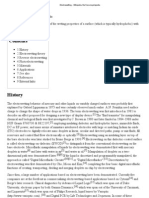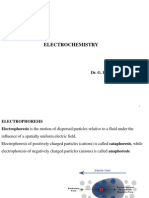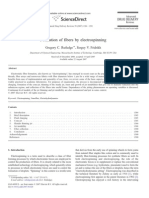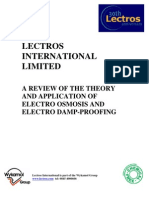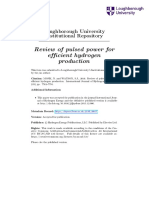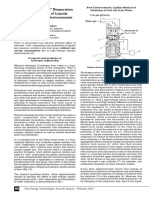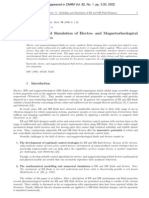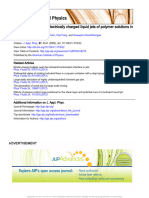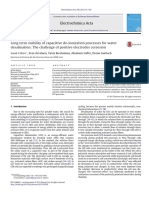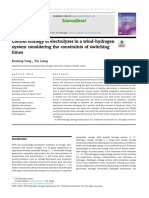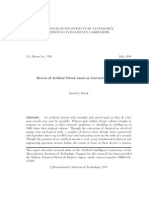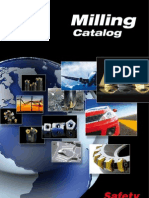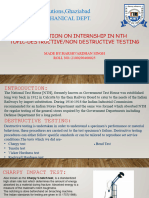Electrorheological Fluid - Wikipedia, The Free Encyclopedia
Electrorheological Fluid - Wikipedia, The Free Encyclopedia
Uploaded by
Sundae bgramCopyright:
Available Formats
Electrorheological Fluid - Wikipedia, The Free Encyclopedia
Electrorheological Fluid - Wikipedia, The Free Encyclopedia
Uploaded by
Sundae bgramOriginal Title
Copyright
Available Formats
Share this document
Did you find this document useful?
Is this content inappropriate?
Copyright:
Available Formats
Electrorheological Fluid - Wikipedia, The Free Encyclopedia
Electrorheological Fluid - Wikipedia, The Free Encyclopedia
Uploaded by
Sundae bgramCopyright:
Available Formats
Electrorheological fluid - Wikipedia, the free encyclopedia http://en.wikipedia.
org/wiki/Electrorheological_fluid
From Wikipedia, the free encyclopedia
Electrorheological (ER) fluids are suspensions of extremely fine non-conducting particles (up to
50 micrometres diameter) in an electrically insulating fluid. The apparent viscosity of these fluids
changes reversibly by an order of up to 100,000 in response to an electric field. For example, a
typical ER fluid can go from the consistency of a liquid to that of a gel, and back, with response
times on the order of milliseconds. The effect is sometimes called the Winslow effect, after its
discoverer the American inventor Willis Winslow, who obtained a US patent on the effect in 1947
[1]
and wrote an article published in 1949.[2]
1 Applications
2 The ER effect
3 ER fluid composition and theory
4 Problems and advantages
5 See also
6 References
The normal application of ER fluids is in fast acting hydraulic valves [3] and clutches, with the
separation between plates being in the order of 1 mm and the applied potential being in the order
of 1 kV. In simple terms, when the electric field is applied, an ER hydraulic valve is shut or the
plates of an ER clutch are locked together, when the electric field is removed the ER hydraulic
valve is open or the clutch plates are disengaged. Other common applications are in ER brakes
[4]
(think of a brake as a clutch with one side fixed) and shock absorbers [5] (which can be
thought of as closed hydraulic systems where the shock is used to try to pump fluid through a
valve).
There are many novel uses for these fluids, including use in the US army's planned future force
warrior (http://www.defense-update.com/features/du-4-04/FFW.htm) project. They plan to create
bulletproof vests using an ER fluid because the ability to soak the fluid into cloth creates the
potential for a very light vest that can change from a normal cloth into a hard covering almost
instantaneously. Other potential uses are in accurate abrasive polishing (http://cat.inist.fr
/?aModele=afficheN&cpsidt=14040048) and as haptic controllers and tactile displays.[6]
ER fluid has also been proposed to have potential applications in flexible electronics, with the
fluid incorporated in elements such as rollable screens and keypads, in which the viscosity-
changing qualities of the fluid allowing the rollable elements to become rigid for use, and flexible
to roll and retract for storing when not in use. Motorola filed a patent application for mobile device
applications in 2006.[7]
The change in apparent viscosity is dependent on the applied electric field, i.e. the potential
第1页 共4页 2013-7-24 22:29
Electrorheological fluid - Wikipedia, the free encyclopedia http://en.wikipedia.org/wiki/Electrorheological_fluid
divided by the distance between the plates. The change is not a simple change in viscosity,
hence these fluids are now known as ER fluids, rather than by the older term Electro Viscous
fluids. The effect is better described as an electric field dependent shear yield stress. When
activated an ER fluid behaves as a Bingham plastic (a type of viscoelastic material), with a yield
point which is determined by the electric field strength. After the yield point is reached, the fluid
shears as a fluid, i.e. the incremental shear stress is proportional to the rate of shear (in a
Newtonian fluid there is no yield point and stress is directly proportional to shear). Hence the
resistance to motion of the fluid can be controlled by adjusting the applied electric field.
ER fluids are a type of smart fluid. A simple ER fluid can be made by mixing cornflour in a light
vegetable oil or (better) Silicone oil.
There are two main theories to explain the effect: the interfacial tension or 'water bridge' theory,[8]
and the electrostatic theory. The water bridge theory assumes a three phase system, the particles
contain the third phase which is another liquid (e.g. water) immiscible with the main phase liquid
(e.g. oil). With no applied electric field the third phase is strongly attracted to and held within the
particles. This means the ER fluid is a suspension of particles, which behaves as a liquid. When
an electric field is applied the third phase is driven to one side of the particles by electro osmosis
and binds adjacent particles together to form chains. This chain structure means the ER fluid has
become a solid. The electrostatic theory assumes just a two phase system, with dielectric
particles forming chains aligned with an electric field in an analogous way to how
magnetorheological fluid (MR) fluids work. An ER fluid has been constructed with the solid phase
made from a conductor coated in an insulator.[9] This ER fluid clearly cannot work by the water
bridge model. However, although demonstrating that some ER fluids work by the electrostatic
effect, it does not prove that all ER fluids do so. The advantage of having an ER fluid which
operates on the electrostatic effect is the elimination of leakage current, i.e. potentially there is no
DC current. Of course, since ER devices behave electrically as capacitors, and the main
advantage of the ER effect is the speed of response, an AC current is to be expected.
The particles are electrically active. They can be ferroelectric or, as mentioned above, made from
a conducting material coated with an insulator, or electro-osmotically active particles. In the case
of ferroelectric or conducting material, the particles would have a high dielectric constant. There
may be some confusion here as to the dielectric constant of a conductor, but "if a material with a
high dielectric constant is placed in an electric field, the magnitude of that field will be
measurably reduced within the volume of the dielectric" (see main page: Dielectric constant), and
since the electric field is zero in an ideal conductor, then in this context the dielectric constant of a
conductor is infinite.
Another factor that influences the ER effect is the geometry of the electrodes. The introduction of
parallel grooved electrodes showed slight increase in the ER effect but perpendicular grooved
electrodes doubled the ER effect.[10] A much larger increase in ER effect can be obtained by
coating the electrodes with electrically polarisable materials. This turns the usual disadvantage of
dielectrophoresis into a useful effect. It also has the effect of reducing leakage currents in the ER
fluid.[11]
The giant electrorheological (GER) fluid was discovered in 2003,[12] and is able to sustain higher
yield strengths than many other ER fluids. The GER fluid consists of Urea coated nanoparticles
of Barium Titanium Oxalate suspended in silicone oil. The high yield strength is due to the high
dielectric constant of the particles, the small size of the particles and the Urea coating. Another
advantage of the GER is that the relationship between the electrical field strength and the yield
第2页 共4页 2013-7-24 22:29
Electrorheological fluid - Wikipedia, the free encyclopedia http://en.wikipedia.org/wiki/Electrorheological_fluid
strength is linear after the electric field reaches 1 kV/mm. The GER is a high yield strength, but
low electrical field strength and low current density fluid compared to many other ER fluids. The
procedure for preparation of the suspension is given in.[12] The major concern is the use of oxalic
acid for the preparation of the particles as it is a strong organic acid.
A major problem is that ER fluids are suspensions, hence in time they tend to settle out, so
advanced ER fluids tackle this problem by means such as matching the densities of the solid and
liquid components, or by using nanoparticles, which brings ER fluids into line with the
development of magnetorheological fluids. Another problem is that the breakdown voltage of air
is ~ 3 kV/mm, which is near the electric field needed for ER devices to operate.
An advantage is that an ER device can control considerably more mechanical power than the
electrical power used to control the effect, i.e. it can act as a power amplifier. But the main
advantage is the speed of response, there are few other effects able to control such large
amounts of mechanical or hydraulic power so rapidly.
Unfortunately, the increase in apparent viscosity experienced by most Electrorheological fluids
used in shear or flow modes is relatively limited. The ER fluid changes from a Newtonian liquid to
a partially crystalline "semi-hard slush". However, an almost complete liquid to solid phase
change can be obtained when the electrorheological fluid additionally experiences compressive
stress.[13] This effect has been used to provide electrorheological Braille displays [14] and very
effective clutches.[15]
Continuum mechanics
Ferrofluid
Fluid mechanics
Smart fluid
Magnetorheological fluid
Electroactive polymers
Electroadhesion
Electroviscous effects
Debye-Falkenhagen effect
3. ^ Simmonds, AJ (July 1991). "Electro-
1. ^ U.S. Patent 2,417,850 rheological valves in a hydraulic circuit". IEE
(http://www.google.com/patents/US2417850): Proceedings-D 138 (4): 400–404.
Winslow, W. M.: 'Method and means for 4. ^ Seed, M; Hobson, GS; Tozer, RC;
translating electrical impulses into mechanical Simmonds, AJ (September 1986). "Voltage-
force', 25 March 1947 controlled Electrorheological brake". Proc.
2. ^ Winslow, Willis M. (1949). "Induced fibration IASTED Int. Symp. Measurement, Sig. Proc.
of suspensions". J. Appl. Phys. 20 (12): and Control. Taormina, Italy: ACTA Press.
1137–1140. Bibcode:1949JAP....20.1137W pp. Paper No. 105–092–1.
(http://adsabs.harvard.edu 5. ^ Stanway, R; Sproston, JL; El-Wahed, AK
/abs/1949JAP....20.1137W). (August 1996). "Applications of electro-
doi:10.1063/1.1698285 (http://dx.doi.org rheological fluids in vibration control: a survey".
/10.1063%2F1.1698285). Smart Mater. Struct 5 (4): 464–482.
第3页 共4页 2013-7-24 22:29
Electrorheological fluid - Wikipedia, the free encyclopedia http://en.wikipedia.org/wiki/Electrorheological_fluid
Bibcode:1996SMaS....5..464S of electrode geometry on the performance of
(http://adsabs.harvard.edu electrorheological fluid valves". Journal of
/abs/1996SMaS....5..464S). Intelligent Material Systems and Structures 14
doi:10.1088/0964-1726/5/4/011 (2): 105–111.
(http://dx.doi.org doi:10.1177/1045389X03014002006
/10.1088%2F0964-1726%2F5%2F4%2F011). (http://dx.doi.org
6. ^ Liu, Y; Davidson, R; Taylor, P (2005). /10.1177%2F1045389X03014002006).
"Investigation of the touch sensitivity of ER 11. ^ Monkman G.J. ‑ Addition of Solid Structures
fluid based tactile display". Proceedings of to Electrorheological Fluids ‑ Journal of
SPIE 5764: 92–99. doi:10.1117/12.598713 Rheology ‑ Vol 35, pp. 1385-7, October 1991
(http://dx.doi.org/10.1117%2F12.598713). 12. ^ a b Wen, W; Huang, X; Yang, S; Lu, K;
7. ^ Foldable/ rollable phone from Motorola Sheng, P (November 2003). "The giant
(http://www.unwiredview.com/2008/01 electrorheological effect in suspensions of
/25/foldable-rollable-phone-from-motorola/) nanoparticles". Nature Materials 2 (11):
8. ^ Stangroom, JE (1983). "Electrorheological 727–730. Bibcode:2003NatMa...2..727W
Fluids". Phys. Technol. 14 (6): 290–296. (http://adsabs.harvard.edu
Bibcode:1983PhTec..14..290S /abs/2003NatMa...2..727W).
(http://adsabs.harvard.edu doi:10.1038/nmat993 (http://dx.doi.org
/abs/1983PhTec..14..290S). /10.1038%2Fnmat993). PMID 14528296
doi:10.1088/0305-4624/14/6/305 (//www.ncbi.nlm.nih.gov/pubmed/14528296).
(http://dx.doi.org 13. ^ Monkman. G.J. – The Electrorheological
/10.1088%2F0305-4624%2F14%2F6%2F305). Effect under Compressive Stress – Journal of
9. ^ Tam, W Y; Yi G H; Wen, W; Ma H; Sheng P Physics D: Applied Physics – Vol. 28, pp
(April 1997). "New Electrorheological Fluid: 588-593 - Institute of Physics, 1995.
Theory and Experiment". Phys. Rev. Lett. 78 14. ^ Monkman. G.J. – An Electrorheological
(15): 2987–2990. Tactile Display – Presence (Journal of
Bibcode:1997PhRvL..78.2987T Teleoperators and Virtual Environments) – Vol.
(http://adsabs.harvard.edu 1, issue 2, pp. 219-228, MIT Press, July 1992.
/abs/1997PhRvL..78.2987T). 15. ^ Monkman. G.J. – Exploitation of
doi:10.1103/PhysRevLett.78.2987 compressive stress in electrorheological
(http://dx.doi.org coupling – Mechatronics – Vol. 7, No. 1, pp.
/10.1103%2FPhysRevLett.78.2987). 27–36 – Pergamon February 1997.
10. ^ Georgiades, G; Oyadiji, SO (2003). "Effects
Retrieved from "http://en.wikipedia.org/w/index.php?title=Electrorheological_fluid&
oldid=540830389"
Categories: Smart materials
This page was last modified on 27 February 2013 at 03:44.
Text is available under the Creative Commons Attribution-ShareAlike License; additional
terms may apply. By using this site, you agree to the Terms of Use and Privacy Policy.
Wikipedia® is a registered trademark of the Wikimedia Foundation, Inc., a non-profit
organization.
第4页 共4页 2013-7-24 22:29
You might also like
- Mill Test Certificate Certificate Conform To: EN 10204/3.1Document1 pageMill Test Certificate Certificate Conform To: EN 10204/3.1GLORIA MONSALVE SALAZAR100% (1)
- Chapter 31: Principles of Active Vibration Control: Electrorheological FluidsDocument12 pagesChapter 31: Principles of Active Vibration Control: Electrorheological FluidsNagarajan PitchandiNo ratings yet
- ER FluidsDocument14 pagesER FluidsKashyap MkNo ratings yet
- Rohini 95583178501Document3 pagesRohini 95583178501mohebalqadasiNo ratings yet
- Introduction: - Electro Rheological (ER) Fluids Basically Consist of Particles That AreDocument3 pagesIntroduction: - Electro Rheological (ER) Fluids Basically Consist of Particles That Aresukanto bagchiNo ratings yet
- Breakdown in Liquid DielectricsDocument5 pagesBreakdown in Liquid DielectricskrishnandrkNo ratings yet
- Electrowetting - Wikipedia, The Free EncyclopediaDocument5 pagesElectrowetting - Wikipedia, The Free EncyclopediaDwane AlmeidaNo ratings yet
- Modern Applications of Electrorheological (ER) Fluids: January 2014Document8 pagesModern Applications of Electrorheological (ER) Fluids: January 2014Maya GlamourstickesNo ratings yet
- Lecture 6 (AHVE)Document24 pagesLecture 6 (AHVE)SAJEEDNo ratings yet
- Electrochemistry: Dr. G. Purna Chandra RaoDocument29 pagesElectrochemistry: Dr. G. Purna Chandra RaosreekanthsharmaNo ratings yet
- A Review in ElectrospinningDocument8 pagesA Review in ElectrospinningMuaathe IbrahimNo ratings yet
- A Review of The Theory of Osmotic Damp Proofing - PDF 20042010-1543-41Document15 pagesA Review of The Theory of Osmotic Damp Proofing - PDF 20042010-1543-41kalpna_n3No ratings yet
- Seminar On: Electro Rheological, Magneto Rheological Fluids & Piezoelectric MaterialsDocument12 pagesSeminar On: Electro Rheological, Magneto Rheological Fluids & Piezoelectric MaterialsMainakMitraNo ratings yet
- Review of Pulsed Power For Efficient Hydrogen ProductionDocument16 pagesReview of Pulsed Power For Efficient Hydrogen ProductionMiguel Arango100% (1)
- Jawaban Soal Liquid Dielectric Santos EdunDocument8 pagesJawaban Soal Liquid Dielectric Santos EdunLuthfi Arif Fadillah100% (1)
- Bending Instability of Electrically Charged Liquid Jets of PolymeDocument19 pagesBending Instability of Electrically Charged Liquid Jets of PolymeyessicaNo ratings yet
- 4 Ijprjun20194Document8 pages4 Ijprjun20194TJPRC PublicationsNo ratings yet
- Electroviscous EffectDocument11 pagesElectroviscous EffectaidaNo ratings yet
- 1 1504171Document9 pages1 1504171TeferiNo ratings yet
- Breakdown in Liquid InsulationDocument5 pagesBreakdown in Liquid InsulationDawood Najem SalehNo ratings yet
- Electro-osmosis - WikipediaDocument6 pagesElectro-osmosis - WikipediagireeshplyNo ratings yet
- Lec25 - Electrolytic Cell Components and Electrolyzer StackDocument15 pagesLec25 - Electrolytic Cell Components and Electrolyzer StackswytzNo ratings yet
- дудышев новая эн 10-19 PDFDocument3 pagesдудышев новая эн 10-19 PDFAleksandrNo ratings yet
- PAN100-ECD-Fundamentals-11.20Document8 pagesPAN100-ECD-Fundamentals-11.20nofah65794No ratings yet
- Breakdown in LiquidsDocument11 pagesBreakdown in Liquidsvinayuv880% (1)
- Module 1 HVE - LiquidsDocument34 pagesModule 1 HVE - Liquidssrinimeha@gmail.comNo ratings yet
- 2016 - A. Electrochemical CellsDocument2 pages2016 - A. Electrochemical CellsHenrique Ribeiro Piaggio CardosoNo ratings yet
- Impact of The Voltage Fluctuation of The Power Supply On The Efficiency of Alkaline Water ElectrolysisDocument3 pagesImpact of The Voltage Fluctuation of The Power Supply On The Efficiency of Alkaline Water ElectrolysisAlex FinnsNo ratings yet
- Zeta PotentialDocument4 pagesZeta PotentialChemPetroNo ratings yet
- Unit VDocument8 pagesUnit VhyctortyNo ratings yet
- Materials 17 01331Document13 pagesMaterials 17 01331Aravind KandaswamiNo ratings yet
- Case StudyDocument7 pagesCase StudyWallisson Mendes OsiasNo ratings yet
- Magneto Rehological Fluid DampersDocument22 pagesMagneto Rehological Fluid DampersvikaseinsteinNo ratings yet
- A Coupled Electro-Hydrodynamic Numerical Modeling of Droplet Actuation by ElectrowettingDocument8 pagesA Coupled Electro-Hydrodynamic Numerical Modeling of Droplet Actuation by Electrowettingmypassion59No ratings yet
- Lecture 11-13 - ElectrowettingDocument78 pagesLecture 11-13 - ElectrowettingViswanath KapavarapuNo ratings yet
- Module 2-Transformers Lecture Notes 2020Document35 pagesModule 2-Transformers Lecture Notes 2020Sahiil MauriceNo ratings yet
- Energies 14 00970 v2Document15 pagesEnergies 14 00970 v2militiamonNo ratings yet
- Zeta Potential - Wikipedia, The Free EncyclopediaDocument4 pagesZeta Potential - Wikipedia, The Free EncyclopediaAni KumarNo ratings yet
- Lec24 - Fundamental of Electrolysis of WaterDocument11 pagesLec24 - Fundamental of Electrolysis of WaterswytzNo ratings yet
- Effect of AC Electric Fields On The Stabilization of Premixed Bunsen AmesDocument8 pagesEffect of AC Electric Fields On The Stabilization of Premixed Bunsen Amesdimas taurusriantoNo ratings yet
- 1-6Document4 pages1-6Abdullah AfzalNo ratings yet
- Electrospinning Distribution of Charges in Liquid JetsDocument6 pagesElectrospinning Distribution of Charges in Liquid Jetsxiaobing DongNo ratings yet
- Sawane 2016 - Electrolyte Concentration Effects On DC Voltage ElectrowettingDocument5 pagesSawane 2016 - Electrolyte Concentration Effects On DC Voltage ElectrowettingGerman David Manrique MedinaNo ratings yet
- No 137Document7 pagesNo 137Hong-Hieu LENo ratings yet
- A Static Model For Electrolyte-Gated Organic Field Effect TransistorsDocument10 pagesA Static Model For Electrolyte-Gated Organic Field Effect Transistorskamru55l.malNo ratings yet
- Neirinck2009 ACEPD PDFDocument4 pagesNeirinck2009 ACEPD PDFCristina ClavijoNo ratings yet
- A Very Stable High Throughput Taylor Cone-Jet in ElectrohydrodynamicsDocument10 pagesA Very Stable High Throughput Taylor Cone-Jet in ElectrohydrodynamicsCHIRANJIT KUMAR MAJHINo ratings yet
- Electrophoresis Is The Motion ofDocument3 pagesElectrophoresis Is The Motion oflittlemuaNo ratings yet
- Electrohydrodynamic Enforcement of Evaporation and Gas FlowDocument7 pagesElectrohydrodynamic Enforcement of Evaporation and Gas FlowMichael ReznikovNo ratings yet
- High Frequency Effects On Corona Discharge TreatmentDocument4 pagesHigh Frequency Effects On Corona Discharge TreatmentMinh Nhân NguyễnNo ratings yet
- Polymer Electrochemistry ExerciseDocument10 pagesPolymer Electrochemistry ExerciseNur Hafizah MukhtarNo ratings yet
- Articulo NanotecnlogiaDocument18 pagesArticulo NanotecnlogiaHector ZaNo ratings yet
- A Reversible Water Electrolyser With Porous PTFE Based OH Conductive Membrane As Energy Storage CellsDocument8 pagesA Reversible Water Electrolyser With Porous PTFE Based OH Conductive Membrane As Energy Storage CellsJosePPMolinaNo ratings yet
- Dynamic Model of A Vanadium Redox Flow Battery For System Performance ControlDocument7 pagesDynamic Model of A Vanadium Redox Flow Battery For System Performance ControlLokesh BaviskarNo ratings yet
- Long Term Stability of Capacitive De-Ionization Processes For Water Desalination: The Challenge of Positive Electrodes CorrosionDocument10 pagesLong Term Stability of Capacitive De-Ionization Processes For Water Desalination: The Challenge of Positive Electrodes CorrosionPaulo Ossandon SanchezNo ratings yet
- Control 2Document8 pagesControl 2RandomV D.ENo ratings yet
- Review of Articial Muscle Based On Contractile PolymersDocument15 pagesReview of Articial Muscle Based On Contractile PolymersWeristIchbin100% (1)
- Zeta Potential: A New ApproachDocument12 pagesZeta Potential: A New Approachelektron2010No ratings yet
- Schalenbach 2016 J. Electrochem. Soc. 163 F3197Document13 pagesSchalenbach 2016 J. Electrochem. Soc. 163 F3197Avishek JaiswalNo ratings yet
- Lubrication of RopesDocument52 pagesLubrication of RopestitanNo ratings yet
- Safety Assessment of Motorcycle Helmet Using Finite Element Analysis Varun Agrawal, Rohit Kumrawat, Rizwan Sheikh & Sanjay JainDocument8 pagesSafety Assessment of Motorcycle Helmet Using Finite Element Analysis Varun Agrawal, Rohit Kumrawat, Rizwan Sheikh & Sanjay JainBikramjeet SinghNo ratings yet
- Transparent ConcreteDocument7 pagesTransparent Concretekrishna reddyNo ratings yet
- Line Insulators & OHL TowersDocument10 pagesLine Insulators & OHL Towersm4_mehdeeNo ratings yet
- The Law of Conservation of MassDocument14 pagesThe Law of Conservation of Masslevi0417No ratings yet
- Catalog: MillingDocument98 pagesCatalog: MillingGabo SolanoNo ratings yet
- DeepFlex BrochureDocument4 pagesDeepFlex Brochureribeiro30No ratings yet
- Destructive and NDT PresentationDocument9 pagesDestructive and NDT PresentationHarshvardhan SinghNo ratings yet
- Cellulose Triacetate Fiber-Reinforced Polystyrene Composite: Usman Saeed, Uthman Dawood and Arshad Mahmood AliDocument15 pagesCellulose Triacetate Fiber-Reinforced Polystyrene Composite: Usman Saeed, Uthman Dawood and Arshad Mahmood AliHd MuluNo ratings yet
- Compressive Membrane Action in RCC Slabs PDFDocument21 pagesCompressive Membrane Action in RCC Slabs PDFTanveer Ahmad100% (1)
- Heatproof 980Document2 pagesHeatproof 980Meliany SariNo ratings yet
- Chapter 2 (Lecture 3)Document25 pagesChapter 2 (Lecture 3)SchaieraNo ratings yet
- Removal of Heavy Metals From Wastewater of Textile Industry Using Polymeric Nano-AdsorbentDocument11 pagesRemoval of Heavy Metals From Wastewater of Textile Industry Using Polymeric Nano-AdsorbentMuhammad Junaid AlviNo ratings yet
- What Is Matter - SummativeDocument2 pagesWhat Is Matter - SummativeJosefina TabatNo ratings yet
- HVA Capsule Adhesive Anchor Unsupported 243544Document2 pagesHVA Capsule Adhesive Anchor Unsupported 243544yhszaNo ratings yet
- Open Die Forging: Forgings RelationshipsDocument2 pagesOpen Die Forging: Forgings RelationshipsGauthamSarangNo ratings yet
- G30-Hi Speed Bearing GreaseDocument3 pagesG30-Hi Speed Bearing GreaseSarfraz HinaNo ratings yet
- Exploration Coring Tools: Diamond BitsDocument39 pagesExploration Coring Tools: Diamond BitsLuis Chavez García50% (2)
- Behringer Industrial Pipe Clamps 2016 PDFDocument38 pagesBehringer Industrial Pipe Clamps 2016 PDFjenny_2809No ratings yet
- 3rd I-CIPEC Babcock & Wilcox VolundDocument5 pages3rd I-CIPEC Babcock & Wilcox VolundMatias MancillaNo ratings yet
- 5143 EDB Steel GradeDocument1 page5143 EDB Steel GradepandianNo ratings yet
- Silicone Sealant DatasheetDocument3 pagesSilicone Sealant Datasheetfariboy123No ratings yet
- Apex Duracast DholpurtexDocument2 pagesApex Duracast DholpurtexKeyur PatelNo ratings yet
- b2wb6024150170bp261017 Aerofoil System (With Strengthening Bar) - Using 60x24mm Rhs Posts With 170 X 150 Base Plates PDFDocument16 pagesb2wb6024150170bp261017 Aerofoil System (With Strengthening Bar) - Using 60x24mm Rhs Posts With 170 X 150 Base Plates PDFatalayyNo ratings yet
- Cellular Concrete ArticleDocument4 pagesCellular Concrete Articleabduyassin8014No ratings yet
- Grain Growth Mechanisms in PolysiliconDocument5 pagesGrain Growth Mechanisms in PolysiliconPk dataNo ratings yet
- Hzard All in OneDocument24 pagesHzard All in OneyasirhistoNo ratings yet
- Preparation and Characterization of Biodegradable Plastic Film From Starch Enriched TubersDocument5 pagesPreparation and Characterization of Biodegradable Plastic Film From Starch Enriched Tubersjadeshades12No ratings yet






